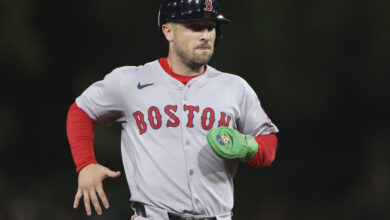
Cubs vs. Brewers Series Review: Fast Start Gives Way to Frustrating Series Loss
One of the most frequently displayed tropes in sports writing is analyzing things in terms of the good, the bad, and the ugly. It’s just so…uninteresting. So please accept my sincerest apologies for the fact that I’m about to use it, but this really was a case of the good, the bad, and the ugly.
Let’s review. I promise, I’ll get to all three.
The good: That Friday game was a blast. Did you see that Nicholas Castellanos bat slam? Oh man, how fun was that?
The bad: Well, the rest of it. Turns out that an opening salvo of sound and fury ultimately signified nothing. A combination of bad luck and poor execution led to the Cubs failing to score another run in the series.
If there was ever a series that represented the 2019 Cubs to this point, this would certainly be it – a lot of promise coupled with some crushing and frustrating disappointment.
Results
Key moments
Friday’s opener represented a continuation of the Castellanos Extension Tour. The Cubs offense was firing on all cylinders, but none fired more emphatically than everyone’s favorite new Cub.
Castellanos went 2-for-4 and those two hits were doozies.
Those double dongs represented over 50% of the Cubs offense for the whole weekend set, which feels about par for the course with Big Stick Nick’s production since joining the team. The follow-through on the second should have been worth an extra run all on its own.
An effective José Quintana and a solid performance by the Cubs bullpen ensured that either home run would have been enough to secure a Cubs win on its own.
The middle game of the series was not so fortuitous. The Cubs hit the ball hard with some regularity, but luck wasn’t on their side. The key moment of the game was undoubtedly Manny Piña‘s two-run single in the 1st inning. Those would be the only runs scored by either team all day.
If there was a bright spot for the Cubs, it’s that Cole Hamels bounced back somewhat from what has been a fairly ineffective stretch for him, The veteran lefty allowed just two runs in six innings, striking out seven Brewers along the way.
The series finale, sadly, provided more of the same. The Cubs were shut out again, squandering a number of scoring opportunities throughout the game.
No missed opportunity stung more than the bottom of the 6th inning. With men on first and second and no outs, Alex Claudio came on to face Jason Heyward with the Cubs mounting their most serious threat so far.
It didn’t last long. Heyward laid down a poor bunt that resulted in a force out at third and Addison Russell grounded into a double play on the very next pitch. Just like that, the inning was over and so was the Cubs chance of breaking the glass marked “score a run.”
Who’s hot
- Quintana has gone from being a near consensus pick to be left out of a playoff rotation to one of the top pitchers on the staff. Over his last seven starts, Q has put up a 2.45 ERA over 40.1 innings, striking out 42 and allowing only eight walks. This is certainly one of the best stretches of his career as a Cub.
- The St. Louis Cardinals. It’s a problem, folks. More on that in a bit.
Who’s not
- Removing Heyward from the leadoff spot didn’t reverse his recent scuffles. Heyward went hitless in the series in six at-bats and is batting just .077 without a walk over his last seven games.
- Russell was involved in a number of blown scoring opportunities, including that brutal double play in the finale. He recorded only a single hit in the series.
Bottom line
I haven’t forgotten about the “ugly” part of our cliché. There was plenty of bad happening at Wrigley Field, but to see the ugly, you have to travel across Illinois’ southwest border.
By winning their four-game series against the Reds, the Cardinals have risen to an enviable position in the NL Central race. With seven games left to play against the Cardinals, the Cubs aren’t yet dead in the water in the division race, but they are in an inarguably precarious position.
While the Cubs’ odds in the Wild Card race remain good, we need look only to last year to see how hazardous that path can be. That goes double if the team continues to go on 20+ inning scoring droughts.

